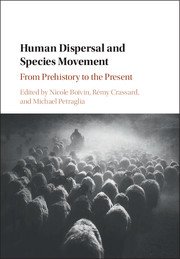Book contents
- Frontmatter
- Contents
- List of text boxes
- List of figures
- List of tables
- List of contributors
- Preface
- I Introduction
- II Origins: Species Movements in the Pleistocene
- III Across the water: Species movements by Coast and Sea
- IV Complexity: Species Movements in the Holocene
- 9 Dispersals, connectivity and indigeneity in Arabian prehistory
- 10 Reconstructing migration trajectories using ancient DNA
- 11 Out of the Fertile Crescent: The dispersal of domestic livestock through Europe and Africa
- 12 Adapting crops, landscapes, and food choices: Patterns in the dispersal of domesticated plants across Eurasia
- 13 Tracing the initial diffusion of maize in North America
- 14 Proto-globalisation and biotic exchange in the Old World
- V Invasion: The Movement of Invasive and Disease Species
- Index
- Plate section
- References
9 - Dispersals, connectivity and indigeneity in Arabian prehistory
from IV - Complexity: Species Movements in the Holocene
Published online by Cambridge University Press: 04 May 2017
- Frontmatter
- Contents
- List of text boxes
- List of figures
- List of tables
- List of contributors
- Preface
- I Introduction
- II Origins: Species Movements in the Pleistocene
- III Across the water: Species movements by Coast and Sea
- IV Complexity: Species Movements in the Holocene
- 9 Dispersals, connectivity and indigeneity in Arabian prehistory
- 10 Reconstructing migration trajectories using ancient DNA
- 11 Out of the Fertile Crescent: The dispersal of domestic livestock through Europe and Africa
- 12 Adapting crops, landscapes, and food choices: Patterns in the dispersal of domesticated plants across Eurasia
- 13 Tracing the initial diffusion of maize in North America
- 14 Proto-globalisation and biotic exchange in the Old World
- V Invasion: The Movement of Invasive and Disease Species
- Index
- Plate section
- References
Summary
Abstract
For a long time, Arabia was perceived as a marginal, peripheral and passive recipient region in prehistory, exploiting innovations from more important centres of development in its vicinity. This chapter aims to qualify this once dominant view. It shows Arabia rather as a largely independent sphere of cultural development, exploring the adaptive evolution of human groups from the Late Pleistocene to the Neolithic through the most recent archaeological records. Latest discoveries indicate that human adaptation in Arabia has a deeper time depth than previously thought, and exhibits a complex and distinctive trajectory. This is particularly observed during the Neolithic period, when Arabian prehistoric groups at different times and different places developed indigenous innovations in concordance with the selective adoption of external elements.
Keywords: Dispersal, Neolithic, lithic technology, animal domesticates, Arabia
INTRODUCTION
As a model for examining processes of dispersal, there are few regions better suited than the Arabian Peninsula. As a region of contrasts – between arid deserts and green oases, humid and dry phases of climatic change and mobile and settled peoples – the peninsula offers an almost ideal laboratory for exploring long-term processes of human dispersal, migration and connectivity. Yet Arabia has also, for many of these same reasons, long been regarded as a marginal region, at the edge of, or even beyond, many of the key developments of human evolution and history. This is due, in part, to the relative paucity of archaeological research conducted in Arabia in comparison with areas to the north. But the marginalisation of Arabian prehistory is also the result of an underlying assumption that more arid environments in the peninsula did not support substantial populations, since obvious signs of long-term settlement were lacking. Until recently, some scholars argued that Arabia was mostly uninhabited prior to the Holocene, only to be progressively populated by groups from the Levant who moved south with their herds and culture. Thus, particularly for later periods, Arabia has generally been characterised as a passive margin or as a satellite of the Levant, where ‘more developed civilisations’ from the north penetrated southern zones.
- Type
- Chapter
- Information
- Human Dispersal and Species MovementFrom Prehistory to the Present, pp. 219 - 236Publisher: Cambridge University PressPrint publication year: 2017
References
- 9
- Cited by



